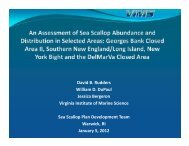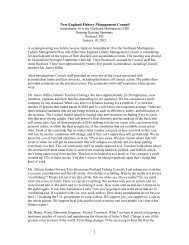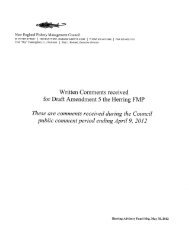Correspondence/Amendment 5 Comments - New England Fishery ...
Correspondence/Amendment 5 Comments - New England Fishery ...
Correspondence/Amendment 5 Comments - New England Fishery ...
Create successful ePaper yourself
Turn your PDF publications into a flip-book with our unique Google optimized e-Paper software.
M.C.TyneII et al. / Fßheries Research 108 (2011) 1-8 s<br />
Table 2<br />
Comparison ofMSY (maximum sustainable yield) based biological reference points (Busv: biomass at maximum sustainable yield, SSBusv: spawning stock biomass at<br />
maximum sustainable yield) produced by explicitly incorporåting predation (= ¡gvi..¿' numerator) and traditional (= ñshery; denominator) methods.<br />
Prey species, author Predators Revised Bs5y or SSBs5y/<br />
Traditional Busv or SSBusv<br />
Atlantic herring, Overholtz et el. (2008)<br />
Atlantic herring, Tyrrell et al. (2008)<br />
Atlantic mackerel, Moustahfid et al, (2009a)<br />
Atlantic mackerel, Tyrrell et al, (2008)<br />
Longfin squid, Mouståhfid et al. (2fr)9b)<br />
29 species inc. fish, mar mamm, seabirds<br />
.11 demersal fish species<br />
13 demersal fish species<br />
1 1 demersal fish species<br />
15 demersal fish species<br />
ered its projected spawning biomass estimates. Similar results have<br />
also been observed for several species simulated for the southeast<br />
Australian fisheries ecosystem (Fulton et al., 2007).<br />
Yield projections for individual species can both increase and<br />
decrease when ecological interactions are taken into account,<br />
depending on the dynamics between the focal species and whether<br />
alternate prey are available. Under the assumption that gray seal,<br />
Halichoerus grypus, predation on Atlantic cod was additive to other<br />
predation mortality, Mohn and Bowen (1996) showed >50% reductions<br />
in yield for cod during a time of increased seal abundance.<br />
Similarly, in the Northeast US, yields of prey species such as herring<br />
will likely decline as their predator stocks recover from decades of<br />
overfi shing (Overholtz et al., 2008).<br />
For predators with limited foraging areas and little alternate<br />
prey, precautionary approaches to calculating fisheries yields are<br />
of critical importance. Everson and de la Mare (1996) incorporated<br />
the requirements of land based predators (seals, penguins,<br />
petrels and other birds) on Antarctic krill, Ëuphausia superba,<br />
around South Georgia Island. They suggested a 75% reduction<br />
in the precautionary catch limit to allow for acceptable impacts<br />
of the krill fishery for these predators with limited foraging<br />
ranges.<br />
2.4. Biological reþrence points are difþrent wíth ecological<br />
considerations<br />
Biological reference points derived with multispecies models<br />
differ from their traditional single-species counterparts in that they<br />
generally result in more precautionary management advice (Hall,<br />
1 999; ICES, 2008). ln addition to the studies described in some detail<br />
below, many other studies support the finding that BRPs change<br />
when predation is explicitly modeled (e.g., ICES, 1997; Collie and<br />
Delong, 1999; Hvingel and Kingsley, 2006). Table 2 summarizes<br />
a suite of studies that explicitly compared BRPs from traditional<br />
stock assessment model parameterization vs. a situation where<br />
consumption on the focal species was calculated and the resulting<br />
revised predation mortalities and biomasses were used for BRP<br />
estimation.<br />
An important example of changed BRPs from including predation<br />
comes from the Baltic Sea ecosystem, where Gislason (1999)<br />
reported complex relationships between reference limits for cod<br />
and herring and sprat, but with a straightforward overriding conclusion<br />
- BRPs of stocks that interact should not be considered<br />
in isolation. Similarly, under the adverse recruitment conditions<br />
of recent decades, Koster et al. (2009) found that incorporating<br />
cannibalism for Eastern Baltic cod lowered the estimated fishing<br />
mortality rate that was required to reach Bpa. Collie and Gislason<br />
(2001) concluded that fishing mortality reference points for prey<br />
such as sprat should be conditioned on changes in predator abundance<br />
andJurado-Molina and Livingston (2002) found that their<br />
three prey species were also sensitive to the harvest levels of their<br />
predators. For Barents Sea capelin Gjøsæter et al. (2002) advocated<br />
stochastic reference points should be developed to account for variable<br />
predation by cod and marine mammals. Accurate calculation<br />
of reference limits, especially for forage species, requires consid-<br />
1.62<br />
1.38<br />
2.71<br />
1.1 1<br />
4.27<br />
Revised MSY/<br />
Traditional MSY<br />
2.39<br />
7.25<br />
1.83<br />
7.57<br />
3.36<br />
eration of the dynamic biomass levels of both predator and prey<br />
populations.<br />
Another example of changed BRPs is the northwest Atlantic<br />
herring fishery. Overholtz et al. (2008) used a delay difference<br />
model to calculate surplus production ofage 2+ herringwith predatory<br />
removals by demersal fishes, marine mammals, large pelagic<br />
fishes and seabirds. The B¡¡5y derived from the model with predation<br />
explicitly incorporated was higher than the fishery only<br />
Brursv by a factor of 1.6. Moustahfid et al. (2009b) incorporated<br />
predatory removals of longfin inshore squid, lolþo peøleii, using<br />
a surplus production model in a similar manner as Overholtz<br />
et al. (2008) and found that B¡aup (a proxy for B¡a5y, maximum<br />
usable production) increased by more than a factor of three when<br />
predation was explicitly accounted for. Similarly, MSY almost doubled<br />
and SSB¡y¡5y increased by almost three times when predation<br />
by 13 demersal fish species was explicitly incorporated into an<br />
age-structured assessment model for Atlantic mackerel (Scomber<br />
scombrus, Moustahñd et al., 2009a). In an MSVPA of 14 predator<br />
stocks and 2 age structured prey species (Atlantic herring and<br />
Atlantic mackerel) of the Northeast US Continental shelf ecosystem,<br />
Tyrrell et al. (2008) found that herring's MSY and Brvrsv<br />
increased in a multispecies vs. single species context, but not to<br />
as strongly as reported by Overholtz et al. (2008). For mackerel, the<br />
MSVPA biomass estimates also resulted in BRPs that were more<br />
conservative than the reference points produced by traditional<br />
single-species methods (Tyrrell et al., 2008). Different types of modeling<br />
approaches (e.g., age structured vs. non-age structured) and<br />
different suites of predators and input parameters have resulted<br />
in variable point estimates of BRPs (e.g., Overholtz et al., 2008 vs.<br />
Tyrrell et al., 2008). Despite variation in the absolute value of BRPs<br />
with and without predation incorporated, B¡a5y or SSBy5y increased<br />
by ,7O% for all situations where these types of comparisons were<br />
made (Table 2). For other reference points such as F.r"r¡ and Fe.1<br />
(both based off of stock-recruitment relationships, with Fe.1 being<br />
the fishing mortality rate at 10% of the maximal yield per recruit<br />
rate, and F.rur6 being the fishing rate which will produce a longterm<br />
spawning biomass per recruit (S/R) equal to the inverse of the<br />
instantaneous rate of variation of R with the biomass, at the initial<br />
point (S = 0, R = 0)), a similar finding of more conservative reference<br />
points being calculated has been reported by other authors. For<br />
example, both Fo.l and F.r"r¡ were lower in a multispecies context<br />
for MSVPAs of the Barents Sea and the North Sea (ICES, 1 997).<br />
As the majority of the aforementioned studies show, inferences<br />
from a variety of models for various fisheries species indicate<br />
that BRPs for forage species are different and generally point to<br />
more conservative harvest rates when ecological considerations<br />
are accounted for. To broaden the applicability to EBFM, BRPS can<br />
also be calculated for a suite of species in addition to individual<br />
values for each species. Mueter and Megrey (2006) aggregated<br />
fisheries species into a surplus production model to calculate an<br />
ecosystem-level MSY (termed multi-species maximum surplus<br />
production) for the Gulf of Alaska and Bering Sea commercially<br />
exploited groundfish species. They found that in both ecosystems,<br />
this ecosystem-level MSY was smaller than the component sum of<br />
single species MSYs (Table 3) and furthermore, that incorporation







